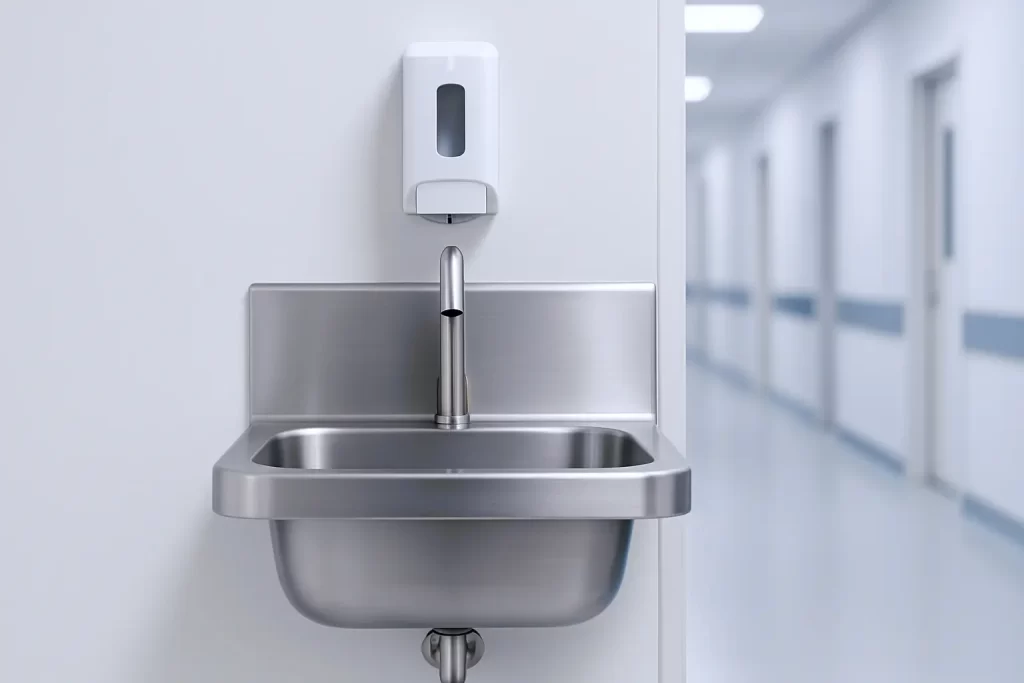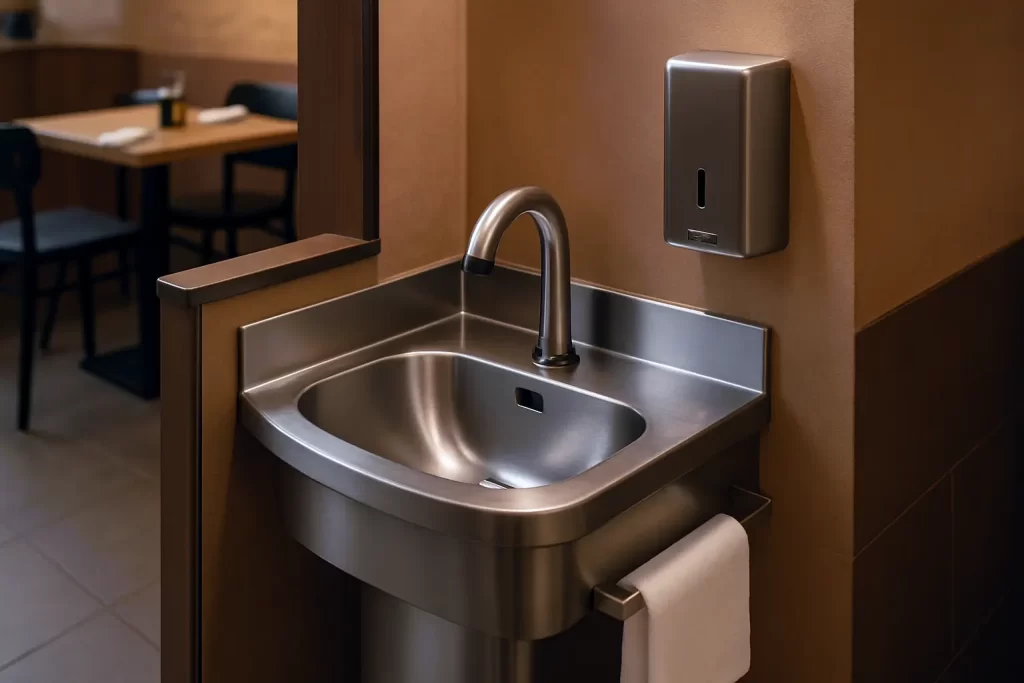Hand Sink and Infection Control: What Buyers Need to Know
In an era where public health awareness is at an all-time high, the humble hand sink emerges as a cornerstone of infection prevention. Data from the Centers for Disease Control and Prevention (CDC) reveals that effective hand hygiene can avert up to 30% of healthcare-associated infections (HAIs), while also curbing the spread of everyday germs in bustling environments like restaurants, schools, and homes. Yet, the effectiveness hinges not just on the act of washing but on the design, placement, and maintenance of the hand sink itself.
We’ll delve into established standards, innovative design elements, material advantages, selection criteria, and upkeep strategies, all supported by insights from authoritative bodies such as the CDC, World Health Organization (WHO), and NSF International.
Why Hand Sink Matter in Infection Control
Hand sinks are specialized fixtures dedicated to handwashing, setting them apart from utility sinks, prep sinks, or three-compartment sinks used for dishwashing or other tasks. In commercial kitchens, for instance, a strategically placed restaurant hand wash station ensures staff can quickly cleanse hands between handling raw ingredients and serving food, aligning with food safety protocols that reduce cross-contamination risks.
From a broader health standpoint, the WHO estimates that poor hand hygiene contributes to millions of infections worldwide each year. Hand sink address this by offering accessible points for compliance, whether in a high-traffic gym where members wash after workouts or a family laundry room sink for post-gardening cleanup. For B2B audiences like procurement managers, this translates to regulatory adherence and operational efficiency; for users, it means fostering everyday wellness, such as installing a portable hand washing sink for outdoor events to maintain hygiene on the go.
Real-world scenarios underscore this importance: During flu seasons, schools with well-distributed hand wash sinks report fewer absences, as per educational health studies. Similarly, in healthcare, dedicated scrub sinks help prevent HAIs, which affect 1 in 31 hospital patients daily according to CDC data.
Understanding Infection Control Standards
Key Guidelines from CDC and WHO
The CDC advocates for handwashing with soap and water for at least 20 seconds when hands are visibly soiled, after restroom use, or before eating—outlining five steps: wet, lather, scrub, rinse, and dry.
Alcohol-based sanitizers are recommended for quick decontamination when sinks aren’t available, but soap and water remain superior for removing certain pathogens like norovirus.
Complementing this, the WHO’s “5 Moments for Hand Hygiene” model—before patient contact, before clean procedures, after body fluid exposure risk, after patient contact, and after touching surroundings—extends beyond healthcare to foodservice and public spaces. Both organizations emphasize that hand sink must be equipped with soap dispensers, paper towels or air dryers, and clear signage to promote proper technique, reducing infection transmission by up to 50% in controlled settings, as evidenced in clinical studies.
Regulatory Requirements for Commercial Hand Sink
Health codes, often drawing from NSF/ANSI standards, mandate specific placements: commercial hand wash sinks should be within 15-25 feet of food preparation areas in restaurants and uniformly distributed in facilities, such as one per three treatment stations in healthcare environments. ADA sink requirements stipulate heights of 34-36 inches with knee clearance for accessibility, while barrier-free designs ensure inclusivity.
| Standard | Key Requirement | Applicable Source |
|---|---|---|
| CDC Handwashing Protocol | 20-second lather with soap; prefer hands-free operations | CDC Clinical Safety Guidelines |
| NSF Certification | Non-porous materials for bacterial resistance; seamless construction | NSF/ANSI Food Equipment Standards |
| ADA Compliance | 34-36 inch mounting height; no barriers | ADA Accessibility Guidelines |
| Local Health Codes | Sinks within 15 ft of high-risk zones; equipped with hygiene supplies | FDA Food Code and Variants |
| WHO Infrastructure | Uniform distribution; prevent splashback | WHO Hand Hygiene Guidelines |
These standards apply across sectors, from commercial bathroom sinks in offices to mop sinks in janitorial areas—though the latter should never double as handwashing stations to avoid contamination.

The Role of Design in Preventing Infections
Thoughtful design transforms a basic hand sink into a robust infection control asset, minimizing risks like splashback or touch-based contamination that can undermine hygiene efforts.
Essential Features for Hygienic Hand Sink
Prioritize hands-free faucets—activated by sensors, foot pedals, or knee controls—to eliminate contact with potentially germ-laden surfaces, a recommendation echoed in ASHE quick guides for healthcare infrastructure. Deep basins (minimum 5-6 inches) and offset drains prevent water pooling and splash, while R-corner designs facilitate thorough cleaning by eliminating sharp edges where dirt accumulates.
For versatility, consider wall mount hand sinks for space-constrained areas like corner kitchen sinks in cafes or portable sinks with water tanks for mobile setups in food trucks and parks. Integrated features, such as built-in soap dispensers and sink drain strainers, further enhance usability, ensuring compliance in diverse applications from garage sinks to laundry utility sinks.
Common Pitfalls and How to Avoid Them
A frequent issue is cross-contamination from manual faucets, where users touch handles after washing, potentially reintroducing germs. Inadequate placement, such as sinks hidden from view, leads to underutilization—studies show visible stations increase compliance by 20-30%. Overly shallow basins cause splashback onto surrounding areas, fostering bacterial growth.
Mitigate these by opting for designs with seamless integral forming to reduce crevices, regular audits of sink drain parts for clogs, and ensuring lighting and signage guide users. In commercial settings, avoid using three-compartment sinks for handwashing, as per FDA rules, to prevent mixing hygiene with warewashing.
Benefits of Stainless Steel in Hand Sink
When it comes to materials, stainless steel stands out for its alignment with hygiene priorities, offering a blend of durability and health-focused properties that other options struggle to match.
Why Stainless Steel Outperforms Other Materials
Stainless steel’s non-porous surface resists bacterial adhesion and corrosion, making it ideal for humid, high-use areas. Grades like 304 stainless steel provide robust everyday performance, while 316 offers enhanced resistance in corrosive environments, such as those with frequent chemical exposure.
Comparisons highlight its superiority: Unlike epoxy, which can crack and harbor microbes, or plastic, which scratches easily, stainless steel maintains integrity over time. Industry reports note it reduces HAIs by facilitating easier sanitization, with a hygiene rating far exceeding alternatives.
| Material Comparison | Durability | Hygiene Benefits | Maintenance Ease | Cost-Effectiveness |
|---|---|---|---|---|
| Stainless Steel (304/316) | High (resists rust, impacts) | Non-porous, antibacterial | Quick wipe-downs | Long-term savings |
| Epoxy Resin | Medium (chemical resistant but brittle) | Moderate (porous over time) | Requires special cleaners | Initial low, high repairs |
| Plastic/Composite | Low (prone to wear) | Low (scratches trap germs) | Easy but frequent | Budget-friendly short-term |
Health and Hygiene Advantages
Beyond basics, stainless steel doesn’t leach chemicals into water, promoting a safer environment—crucial in settings like schools or hospitals. Its smooth finish allows for rapid disinfection, preventing biofilm formation that can lead to outbreaks. In foodservice, stainless utility sinks help meet NSF standards by minimizing odor absorption and stain retention, contributing to overall public health.
Environmental perks include recyclability, aligning with sustainable practices without compromising on hygiene. Real-life applications, such as in healthcare scrub sinks, demonstrate how these properties translate to fewer infections, with facilities reporting improved outcomes post-upgrade.
Long-Term Value in Diverse Settings
Over years of use, stainless steel’s resilience against daily wear—from hot water to abrasive cleaners—ensures consistent performance. In commercial sinks for restaurants or public wall mount sinks, this durability reduces replacement frequency, offering economic benefits alongside health gains.
Choosing the Right Hand Sink for Your Needs
Selecting a hand sink requires evaluating factors like intended use, compliance needs, and budget to ensure it fits seamlessly into your space.
Factors to Consider
Key considerations when selecting a hand sink include:
- Compliance & Quality: NSF certification and durable materials like stainless steel ensure safety and longevity.
- Scalability & Integration: Easy adaptation for bulk installations and seamless connection to existing plumbing.
- Design & Functionality: Aesthetic appeal, appropriate size, water efficiency, and optional features such as sprayers or drainboards.
- Cost-effectiveness: While upfront prices may vary, investing in robust stainless laundry sinks delivers long-term savings.
Application-Specific Recommendations
- Foodservice (Restaurants, Cafes): Commercial hand sink with foot pedal and drainboard for efficient drying; wall mount to optimize floor space in tight kitchens.
- Public and Recreational Spaces (Parks, Gyms, Schools): Portable sink with hot water and self-contained tanks for flexibility; ADA compliant sink for inclusivity.
- Residential and Small-Scale (Homes, Garages): Underslung kitchen sinks or laundry room utility sink with easy-clean features; consider corner sink kitchen for space efficiency.
- Healthcare and High-Risk (Hospitals, Labs): Infection prevention sinks with seamless designs and hands-free controls; deep utility sink to minimize splash.
In each case, verify local codes— for instance, food trucks may require portable camper sinks compliant with mobile hygiene rules.
Budget and Installation Insights
Entry-level models start affordably, but investing in quality pays off. Professional installation ensures proper sink drain plumbing, avoiding issues like slow draining sinks or leaky fittings.

Maintenance and Best Practices
Daily and Long-Term Maintenance Tips
Daily: Rinse basins with mild soap, wipe faucets, and clear sink drain strainers to prevent clogs. Weekly: Disinfect with approved cleaners, inspect for leaks in sink drain pipes, and test hands-free mechanisms.
Long-term: Annually check for corrosion, replace worn sink faucet parts, and deep-clean to address biofilm. For stainless sinks, avoid harsh abrasives to preserve the protective layer—simple vinegar solutions often suffice for shine and sanitation.
| Maintenance Schedule | Tasks | Frequency | Benefits |
|---|---|---|---|
| Daily Rinse | Wipe basin, faucet; clear debris | Every use/end of day | Prevents buildup, maintains flow |
| Weekly Disinfect | Use CDC-approved agents; check drains | Once a week | Kills 99% of germs; avoids odors |
| Monthly Inspection | Test features; clean traps | Monthly | Identifies issues early |
| Annual Deep Clean | Professional service if needed | Yearly | Extends lifespan, ensures compliance |
Integrating Hand Sinks into Infection Control Protocols
Embed sinks in broader strategies: Train users on CDC techniques, monitor usage via signage or audits, and pair with sanitizers for comprehensive coverage. In workplaces, position sinks visibly to boost adherence—research shows this can increase handwashing rates by 25%. Address common issues like smelly sink drains promptly with enzymatic cleaners to maintain a welcoming, hygienic space.
Troubleshooting Common Maintenance Challenges
If facing a clogged sink drain, use non-chemical plungers first to avoid damaging finishes. For slow draining bathroom sinks, regular hair catchers prevent buildup. Always prioritize eco-friendly methods to align with health-focused goals.
Conclusion
Hand sinks are vital for infection control, combining standards, innovative designs, and durable materials like stainless steel to promote safer spaces in commercial and home settings. By applying these insights, buyers can choose compliant options that boost health outcomes. Ready to optimize your setup? Contact us at Xinhe for expert guidance on NSF-certified stainless steel hand sinks.






